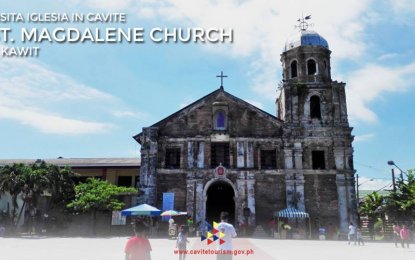
HISTORICAL CHURCH. St. Magdalene church in Kawit town is among the plethora of historical churches that devout Catholics go to for their Visita Iglesia this Holy Week. One of the oldest in the Philippines, the church is where Emilio Aguinaldo, the president of the First Philippine Republic, was baptized. (Photo courtesy of Cavite tourism office)
IMUS CITY, Cavite - Cavite’s tourism office is inviting devout Catholics to embark on their tradition of visiting seven churches or the Visita Iglesia in the province’s historic and centuries-old churches.
The invitation is in support of the recently launched tourism campaign 'Tara, Cavite Tayo!," meant to promote Cavite anew as the nearest complete travel destination from Manila that offers a variety of leisure options.
Provincial Tourism officer-in-charge Elinia Imelda Rozelle S. Sangalang said Wednesday that the provincial tourism came up with the (campaign) idea taking advantage of the fact that coming to Cavite is just a day trip away, "so there's no need to book flights, no extra expenses for hotels, no excessive plannings, you can simply say, 'Tara Cavite Tayo!' and have your escape right away."
Besides the slogan, the driving force of the campaign is its open invitation style, simply asking anyone to come over, including the Caviteǹos themselves, as it is "more of instilling pride, a solidifying aspect internally within the tourism board of Cavite and other stakeholders so all could work together for a common goal that is to promote the beauty of Cavite," said Sangalang.
Pilgrims may make their first stop at “Iglesia Catolica Apostolica Romana Parish” of St. Michael the Archangel located along Evangelista Street in Bacoor Town where Fr. Mariano Gomez – one of its Parish Priest is the GOM in the GOMBURZA – the famous acronym for the three Filipino priests who were executed for charges of subversion arising from the 1872 Cavite mutiny.
Kawit is also home to the Church of St. Mary Magdalene where the first President of the Philippine Republic General Emilio Aguinaldo was baptized and located just a few meters away from the Revolutionary General’s mansion, now a national shrine.
Aguinaldo was known to be a devotee of Mary Magdalene, the patroness whom historians believed was the President’s inspiration in establishing his Katipunan faction “Magdalo.”
Another popular church in Cavite is the Imus Cathedral of Our Lady of the Pillar, which was built by the Jesuits in the 1600s and is known for its priceless religious relics and high vaulted ceilings reminiscent of the Spanish colonial era and the Katipunan period.
The cathedral was declared a structure of historical significance by the National Historical Institute in November 2006.
In Dasmariňas City, the Immaculate Conception Church was the first Catholic Church in the city and was the site of a bloody “Battle of Perez Dasmariňas” – a Cavite offensive commanded by Maj. Gen. Jose de Lachambre in 1897 to recapture Cavite after its defeat during the twin battles of Binakayan and Dalahican.
Saint Francis of Assisi Parish Church in General Trias is where the Banda Matanda, a local marching band practiced the Marcha Filipina – the music of the Philippine National Anthem, before the marching band played it when independence was proclaimed in Kawit town in 1898.
In Silang town sits the church known for its Spanish colonial architectural style and rococo-influenced retablos called the Our Lady of Candelaria Parish Church, declared as a national cultural treasure in 2016.
The church served as kuta (camp) of the guardia civil (civil guards) at the height of the might of Filipino revolutionaries against the Spanish colonial friars in 1896.
In Maragondon town, the church which served as Emilio Aguinaldo’s base during the Philippine Revolution in 1897 is the Our Lady of the Assumption Parish Church.
In this upland Cavite town, another famous Katipunero Supremo Andres Bonifacio of the Katipunan “Magdiwang” Faction was tried, jailed, and executed.
Built in 1663 by the Jesuit missionaries, the Sto. Nino de Ternate Parish nestled in Cavite’s western coastal town is the church where early parishioners believed in the miraculous Holy Image of Santo Niño that was left intact after a local battle ruined the church structure.
Besides the seven famous Catholic churches, there are equally famous and historical churches that were “impressively” restored after these were also burned and destroyed at the height of the Philippine Revolution against the Spanish colonial government.
These restored churches include the 18th century St. Gregory the Great Parish in Indang town, which is known for its impressive interiors, paintings on the ceiling and the old pulpit platform where an officiating priest stands visibly during mass.
Another old church in Tanza town is the Sta Cruz Parish Church where General Emilio Aguinaldo and General Mariano Trias took their oaths as President and Vice President, respectively of the Philippine Revolutionary Government some 120 years ago.
As the only Christian country in Asia, Holy Week is a very sacred time for Filipinos – a time for reflecting and penance, where various traditions are performed like pabasa (chanting/singing), Visita Iglesia and Station of the Cross. (PNA)
